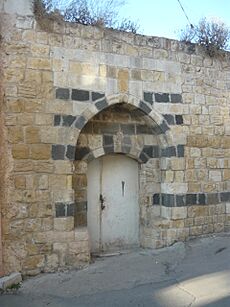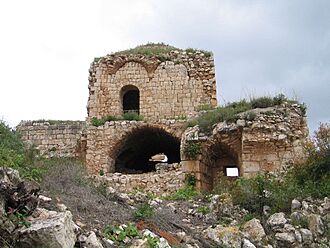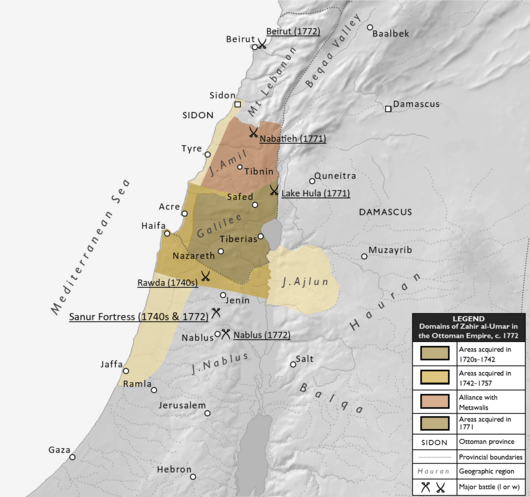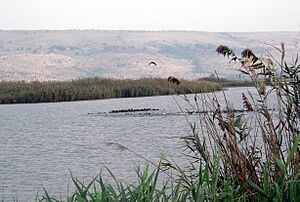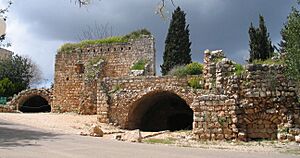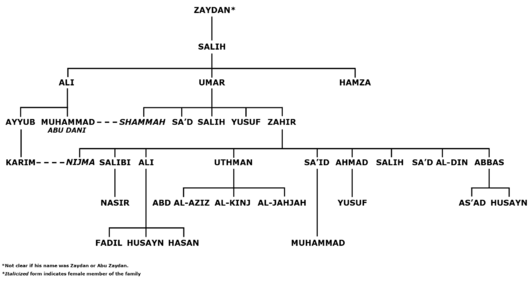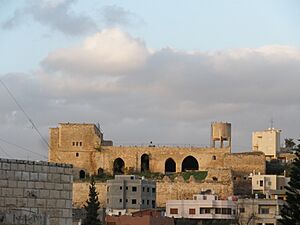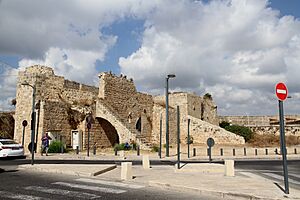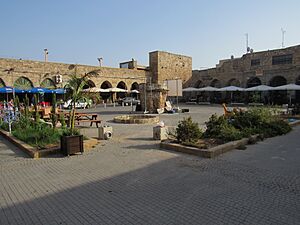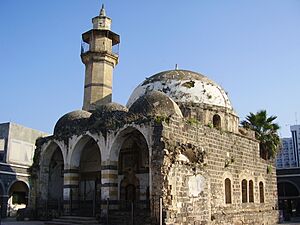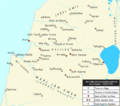Zahir al-Umar facts for kids
Quick facts for kids
Zahir al-Umar
|
|
|---|---|
| ظاهر العمر | |
| Governor of Sidon, Nablus, Jerusalem, Gaza, Ramla, Jaffa and Jabal Ajlun | |
| In office 1774–1774 |
|
| Preceded by | Darwish Pasha al-Kurji (Sidon) |
| Succeeded by | Jazzar Pasha (Sidon) |
| Sheikh of Acre and All Galilee Emir of Nazareth, Tiberias and Safed |
|
| In office 1768–1775 |
|
| Preceded by | None |
| Succeeded by | Jazzar Pasha (as governor Acre) |
| Personal details | |
| Born | 1689 or 1690 Arraba, Sidon Eyalet, Ottoman Empire |
| Died | 21 or 22 August 1775 Acre, Sidon Eyalet, Ottoman Empire |
| Relations | Banu Zaydan (family) |
| Children |
|
| Parent | Umar al-Zaydani |
Zahir al-Umar al-Zaydani (born 1689/90 – died 1775) was an Arab ruler in northern Ottoman Palestine during the mid-1700s. This area was part of the Ottoman Empire at the time. Starting in the 1730s, Zahir mostly ruled the Galilee region. His main cities were Tiberias, Deir Hanna, and later Acre (from 1750). He made Acre a strong city and a key place for trading cotton between Palestine and Europe. In the mid-1760s, he also rebuilt the port town of Haifa nearby.
Zahir often faced attacks from Ottoman governors in Damascus. These governors wanted to stop his growing power. Zahir often got help from the Shia Muslim groups in Jabal Amil. In 1771, Zahir teamed up with Ali Bey al-Kabir from Egypt Eyalet and had support from Russia. Together, they took over Sidon and Damascus, directly challenging the Ottoman sultan. By 1774, Zahir's rule stretched from Beirut to Gaza. It also included the Jabal Amil and Jabal Ajlun areas. However, Ali Bey was killed, and the Ottomans made peace with Russia. This allowed the Ottoman government to focus on stopping Zahir. The Ottoman Navy attacked Acre in 1775, and Zahir was killed outside the city walls.
Zahir became rich by controlling the cotton and olive oil trade from Palestine to Europe. This money helped him run his area. For most of his time in power, he had a good government and kept the area safe. He also stopped several rebellions by his own sons. People liked Zahir because he had fair tax rules and was known as a strong leader. He welcomed different religious groups, which encouraged Christian and Jewish people to move to his lands. More people coming in helped the local economy grow. The Christian communities in Acre and Nazareth, and the Jewish community in Tiberias, grew a lot. Zahir and his family, the Banu Zaydan, built many shops, places of worship, and forts in the Galilee. Today, Zahir is seen as a national hero by many Palestinians because he ruled an almost independent area.
Contents
Zahir's Early Life and Family Background
Zahir was born around 1690. His father, Umar, was a leader, or sheikh, of the Banu Zaydan family. This family was originally Bedouin (nomadic Arabs). But Zahir's grandfather, Salih, stopped being nomadic and settled in the Tiberias area in the late 1600s. Zahir's mother was from the Sardiyya, a Bedouin tribe.
Around 1698, Umar became a tax collector for the Safed district. He was appointed by Bashir Shihab, a powerful Druze leader from Mount Lebanon. The Sidon province, or eyalet, covered the Galilee, southern Mount Lebanon, and the nearby coast. By 1703, Umar was seen as the most important sheikh in the Galilee. His brothers also collected taxes in other parts of the Galilee. Umar died in 1706, and Zahir's oldest brother, Sa'd, took over the family.
The Zaydans lost their tax-collecting role in 1707 but got it back in 1711. Sometimes, during Zahir's teenage years, the family would put him in charge of the tax collection. This was to avoid trouble if they couldn't pay the government. Being in legal control gave Zahir a lot of power within his family.
In 1707, Zahir killed a man in Tiberias during a fight. This made Sa'd move the family from Tiberias. They settled in Arraba, a village between Tiberias, Safed, and Nazareth. The Banu Saqr Bedouin tribe, who lived in Arraba, offered them a safe place. In Arraba, Zahir got some education from a Muslim scholar. He also learned how to hunt and fight.
Between 1713 and 1718, the nearby village of Bi'ina was attacked. Zahir helped defend it and avoided the governor's soldiers. People at the time said this event, along with his calm personality, made him a local hero. His fighting skills earned him more respect among the farmers, or fellahin, in the 1720s.
Sa'd and Zahir also gained respect from the people of Damascus. They continued the trade relationships their father had started. The money the Zaydans made from trading with Damascus and Aleppo helped them become tax collectors. In the 1720s, Zahir often traveled to Damascus to buy and sell goods. There, he met a Muslim scholar who introduced him to a powerful family. Zahir married the daughter of this family and set up her home in Nazareth. When her father died, Zahir inherited his wealth.
How Zahir Gained and Kept Power
Taking Control of Tiberias
Around 1730, the governor of Sidon and local leaders from Jabal Nablus (Samaria) worked together. They wanted to stop the Saqr Bedouins, who had been causing trouble. The Saqr tribe asked Zahir to talk to the government for them. Their leader chose Zahir over his older brother, Sa'd. This showed the Saqr didn't want to be fully under the Zaydans' control.
Soon after joining the Saqr, Zahir began to take over Tiberias with their help. Zahir captured the town's governor and sent him to Sidon. He wrote a letter saying the governor was unfair and taxed people too much. Zahir asked to be the tax collector for Tiberias and Arraba. He promised to pay taxes on time and rule fairly. The governor of Sidon agreed. This was the first time a Zaydani leader was directly appointed by a provincial governor. Zahir made Tiberias his main base. His Zaydani relatives joined him there. He made his cousin Muhammad the leader of the family's soldiers. Zahir spent the 1730s making Tiberias stronger and expanding his territory.
Expanding North and West
Because Zahir ruled fairly, people from nearby areas moved to his lands. Or they asked him to rule over them. People in the Jiddin district, in the northwestern Galilee, asked Zahir for help. Their leader, Ahmad al-Husayn, was too harsh and Bedouins were stealing from them. Zahir agreed and got permission from Sidon's governor to take over the area. Ahmad also asked to attack Zahir. The governor agreed, hoping both powerful leaders would weaken each other.
In 1738, Zahir gathered 1,500 fighters. He defeated Ahmad's forces near the Jiddin fortress. He took control of the fortress and nearby areas like Abu Sinan and Tarshiha. He then officially became the tax collector for Jiddin. During this fight, Zahir met a soldier named Ahmad Agha al-Dinkizli. Zahir hired him to create and lead a private army of soldiers from North Africa.
Zahir then moved to Safed. Its leader, Muhammad al-Naf'i, gave up the town around 1740. This happened after long talks and military pressure. Controlling Safed, with its fort on a high hill, gave the Zaydans power over the surrounding countryside. After this, the strong village of Bi'ina joined Zahir's lands. He had tried to capture it in 1739. This time, it was through an agreement sealed by Zahir marrying the village leader's daughter. He also got the fortress of Suhmata through talks. Then he took the nearby strong village of Dayr al-Qassi by marrying its sheikh's daughter. All these gains made his control over the northern and eastern Galilee stronger.
Elsewhere, Sa'd took control of Deir Hanna and made it his base. Their cousin Muhammad, who already controlled Damun, added Shefa-Amr to his lands. This increased the Zaydans' presence in the western Galilee.
Taking Nazareth and Conflicts with Nablus
By the end of 1740, Nazareth, a mostly Christian town, came under Zahir's control. This happened after he captured Safed. Zahir's rule expanded south towards Nazareth and the Marj Ibn Amer plain. This plain was important for trade routes between Damascus and Nablus. Although Nazareth was part of the Sidon province, it was controlled by leaders from Nablus Sanjak. Nazareth was home to Zahir's first wife and his second wife. Through these connections, he built good relationships with its people. They preferred Zahir, who was known for religious tolerance, over the leaders of Nablus, who they saw as harsh.

The powerful families of Jabal Nablus, especially the Jarrar family, fought against Zahir's advance. They even got the Saqr tribe to help them. By then, the Saqr tribe had turned against Zahir. They were upset he stopped their raids on farmers in his lands. Probably after 1738, Zahir, with his relatives, North African soldiers, and Nazareth residents, defeated the Jarrar-Saqr group. This battle happened near al-Rawda village in Marj Ibn Amer.
After his victory, Zahir called for more fighters from his lands to take over Jabal Nablus. Many Nazareth residents helped, including Christian women who brought food and water. Zahir's forces chased the Jarrars to their village of Sanur. But they couldn't capture its fortress. This defeat showed the limit of Zahir's power south of Marj Ibn Amer. It also confirmed the Jarrars as the main power in Jabal Nablus. The Jarrars and Zahir eventually made peace. But the Jarrars kept gathering other groups in Jabal Nablus to stop Zahir from expanding south.
Battles and Peace with Damascus
Zahir's rise happened at the same time as the Azm family grew powerful. Members of this family governed Damascus for over 25 years. They often tried to expand their control to Tripoli and Sidon provinces. Sulayman Pasha al-Azm became governor of Sidon in 1733, then Damascus in 1734. He didn't like Zahir's growing power near his province and his moves into Nablus.
Even more worrying were Zahir's attacks east of the Jordan River. In 1737 and 1738, he raided the Golan Heights and the Hauran plain. He also attacked Damascus city. Because he threatened Damascus, the government saw him as a danger to the important Hajj pilgrim trip to Mecca. This trip was led by the Damascus governor each year. With permission from Constantinople, Sulayman Pasha attacked Zahir in 1738, but failed. The Banu Saqr then captured Zahir's brother, Salih, and gave him to Sulayman Pasha, who executed him. This made Zahir even more angry at the Saqr.
Sulayman Pasha tried again to stop the Zaydans in 1741. He got his nephew, Ibrahim Pasha of Sidon, to help. But Zahir defeated Ibrahim Pasha near Acre. In September 1742, Sulayman Pasha attacked Tiberias for ninety days. He had orders from Constantinople to kill Zahir. Zahir said he was loyal to the Ottoman sultan, but couldn't convince Sulayman Pasha. When Sulayman Pasha left to lead the Hajj trip, Zahir got French traders in Acre and Jewish allies in Tiberias to talk to officials in Constantinople. His efforts failed. Sulayman Pasha started the attack again in July 1743. But he died suddenly in August outside Tiberias. Zahir used this chance to attack his camp and take weapons and goods.
Sulayman Pasha's nephew, As'ad Pasha al-Azm, became the new governor. He stopped fighting Zahir. The next fourteen years were peaceful between Zahir and Damascus. This was partly because As'ad Pasha learned from his brother's failure and was busy with local issues. In late 1757, the Banu Sakhr and Sardiyya tribes attacked the Hajj trip on its way back to Syria. Thousands of pilgrims were killed. This shocked the government and made the Damascus governor, Husayn Pasha, look bad. Husayn Pasha accused Zahir of being involved in the raid. Zahir denied it and asked for an investigation. To gain the government's favor, he bought the stolen goods from the Bedouins. He returned them to Sultan Mustafa III. Husayn Pasha was replaced by Uthman Pasha al-Kurji in 1760.
Controlling Acre and Haifa

Zahir slowly took control of the port of Acre starting in the 1730s. This was important because he already controlled the rich farmland around Acre. He needed a way to trade by sea. Zahir traded with French merchants in Acre through his partner, Yusuf al-Qassis. His first contact with them was in 1731 when he helped his brother Sa'd settle debts. Controlling Acre would greatly improve his business. The peace with Damascus under As'ad Pasha allowed Zahir to focus his military on the city.
In 1743, Zahir had his cousin Muhammad arrested and executed. This was to remove him as a rival for power in Acre. That year, Zahir asked Ibrahim Pasha for control of Acre. But Ibrahim Pasha, worried about Zahir's growing power, said no. Zahir took Acre by force, probably in 1744, and killed its leader. After getting Muslim scholars and judges to ask the sultan for him, Zahir was officially appointed leader of Acre in July 1746.
In the first few years after taking Acre, Zahir lived in Deir Hanna. He started building a wall around Acre in 1750. He built other forts and public buildings in Acre. He also encouraged people to move to the city, which became his new main base. After that, Zahir took five villages near Acre as his own land. He also built water mills on the Na'aman and Ga'aton Rivers.
In 1757, Zahir expanded his lands south along the coast. He took control of Haifa, Tira, and Tantura villages, and nearby Mount Carmel. Zahir said he captured Haifa to get rid of pirates. But he probably also wanted to stop Damascus governors from using the port against him. He also wanted another port for his lands. While As'ad Pasha didn't act against Zahir taking Haifa, Uthman Pasha wanted to return the port to Damascus. In May 1761, the governor of Sidon sent soldiers to capture Haifa. Zahir had the ship taken, the soldiers arrested, and the captain fined. The issue was resolved with help from a friendly official in Constantinople.
Family Conflicts
To protect his interests in the Galilee, Zahir placed his sons in important forts across the region. In the 1760s, many of his sons started fighting against him and each other. They wanted to expand their own lands, expecting their aging father to die soon.
In 1761, Zahir had his son Uthman kill Sa'd, who was Zahir's main advisor. In return, Uthman was promised control of Shefa-Amr. But Zahir didn't keep his promise. So, Uthman and his brothers Ahmad and Sa'd al-Din attacked Shefa-Amr in 1765, but they were pushed back. In May 1766, Uthman rebelled again but was defeated. A peace meeting was held near Tyre. Zahir and Uthman made up, and Uthman was given control of Nazareth.
In September 1767, a fight started between Zahir and his son Ali. Ali controlled Safed. The conflict was because Zahir refused to give Ali the important fort villages of Deir Hanna and Deir al-Qassi. Before this, Ali had been a strong supporter of his father. He helped stop his brothers' disagreements and outside threats. Zahir's forces marched on Safed later that month, forcing Ali to give up. Zahir forgave Ali but gave him Deir al-Qassi.
The family conflict started again weeks later. Ali and his brother Sa'id were against Zahir and Uthman. Zahir's financial advisor helped make a deal. Sa'id got control of the villages of Tur'an and Hittin. Ali didn't give up and took over Deir Hanna, which Zahir had refused him earlier. Zahir's oldest son, Salibi, who controlled Tiberias, joined Ali. They defeated Zahir, who had sent his soldiers home and was relying on local volunteers. Zahir called back his North African soldiers and defeated Ali. Ali fled Deir Hanna in October. Still, Zahir forgave Ali for a payment and gave him the fort village. By December 1767, Zahir's family problems had calmed down.
The rebellions by Zahir's sons were almost always supported by the Damascus governor, Uthman Pasha. He wanted to keep the family fighting to weaken Zahir. Zahir complained to the government about Uthman Pasha helping his rebellious sons. Zahir got support from the Sidon governor, Muhammad Pasha al-Azm. Muhammad Pasha was against Uthman Pasha and wanted the Azm family back in power in Damascus. Sidon's support didn't help Zahir militarily. But it gave him official approval during his family's rebellions.
Working with the Metawalis of Jabal Amil
When Zahir took over the Safed region and western Galilee, it brought him closer to the Twelver Shia Muslim groups of Jabal Amil. This area was mostly Shia and was located between the Shihabs in Mount Lebanon and the Zaydans in northern Palestine. In 1743, Nassar, the leader of the Ali al-Saghirs, the main Metawali group, helped government forces fight Zahir. Around 1750, Nassar's son, Zahir al-Nassar, asked Zahir for help against the Shihabs. The Shihabs had killed many Shia villagers and looted Jabal Amil. With Zahir's help, the Ali al-Saghirs defeated the Shihabs at Marjayoun. Zahir al-Nassar died that year, and his brother, Nasif al-Nassar, became the most powerful Metawali leader.
Nasif and other Metawali leaders supported Zahir's son Uthman when he rebelled in 1766. Then they supported his son Ali in 1767. During the conflict, Zahir captured the fortified Metawali villages of Bassa and Yaroun. These were on the edge of Zaydani territory. After some fights, the two sides battled at Tarbikha village on October 6, 1766. Some say Zahir won, others say Nasif won. After this, Zahir's North African soldiers supposedly tricked Nasif. They captured two of his young sons from his base, the Tebnine castle. This forced Nasif to talk about peace.
Even with their conflict, Zahir and the Metawalis both wanted to limit the power of Sidon. They also wanted to keep the Druze forces of Mount Lebanon away. Zahir's son Uthman helped end the conflict. He arranged a treaty between Zahir and Nasif on November 24, 1767. Under the treaty, Zahir kept Bassa and Yaroun. He would also represent the Metawalis in their dealings with the Sidon governor. He reduced their taxes to Sidon by a quarter. He promised to support the Metawalis against the Shihabs and Druze. In return, the Metawalis would give him military support. This meant Zahir became the unofficial leader of Jabal Amil, greatly expanding his territory. The support of about 10,000 Metawali fighters greatly increased his military strength. The Metawalis stayed loyal allies, helping in fifteen more campaigns against Zahir's enemies. This alliance secured Zahir's northern borders. It allowed him to focus on operations in the south.
Zahir's Greatest Power
In 1768, the Ottoman government partly recognized Zahir's power. They gave him the title 'Sheikh of Acre, Emir of Nazareth, Tiberias, Safed, and Sheikh of all Galilee'. But this recognition was short-lived. His allies in Constantinople died or were executed. In November 1770, Uthman Pasha arranged for his son, Darwish Pasha, to become Sidon's governor. His other son became governor of Tripoli. Uthman Pasha was determined to end Zahir's rule. Zahir was especially vulnerable without support in the capital.
To respond to threats from Damascus, Zahir made Acre's forts even stronger. He gave every adult man in the city a rifle, two pistols, and a sword. He fixed his relationships with his sons, who controlled areas across the Galilee. He also strengthened his ties with the Shia groups of Jabal Amil. This made his local alliances very strong.
Working with Ali Bey and War with Damascus

Zahir had no support in Constantinople or Damascus. But he was forming a new alliance with Ali Bey al-Kabir, the powerful governor of Egypt. Ali Bey wanted to expand his influence into Syria. He and Zahir both wanted to defeat Damascus. Ali Bey sent 15,000-20,000 Egyptian soldiers to Gaza and Jaffa under commander Ismail Bey. Zahir and Ismail crossed the Jordan Valley with their armies. They moved north towards Damascus. They reached Muzayrib. But Ismail suddenly stopped his army. He saw Uthman Pasha leading the Hajj trip and didn't want to harm the Muslim pilgrims. Ismail thought attacking the governor then would be a serious religious wrong. He then went back to Jaffa.
Zahir was surprised and angry that Ismail didn't attack. Zahir then acted on his own. He had his son Ahmad and other commanders collect taxes from villages in Damascus province. He also sent Ali to fight a tribe in the Hauran, also part of Damascus. In response to Zahir's anger, Ali Bey sent him 35,000 soldiers under Abu al-Dhahab in May. Together with Ismail's soldiers in Jaffa, the Egyptian army captured Damascus from Uthman Pasha in June. At the same time, Zahir and his Metawali allies captured Sidon from Darwish Pasha.
However, Abu al-Dhahab was convinced by Ismail that fighting the Ottoman sultan was wrong. The sultan was seen as the leader of Islam. Soon after taking Damascus, Abu al-Dhahab and Ismail left the city. People at the time were "completely astonished" by this. This sudden change forced Zahir's forces to leave Sidon on June 20.
Abu al-Dhahab leaving made Zahir frustrated. He then made his own moves. First, he captured Jaffa in August 1771. He drove out its governor. Soon after, he captured the cotton-producing Bani Sa'b district. Zahir made Jaffa stronger and placed 2,000 soldiers there. By the end of August, Uthman Pasha got back control of Ramla and Gaza. But Zahir kept Jaffa.
Zahir tried to expand his power to Nablus, a key trade center in Palestine. He attacked Nablus in late 1771. By then, he had allied with the Jarrars. They were angry that Uthman Pasha had appointed a rival as tax collector. Nablus was controlled by the Tuqan and Nimr families, who were rivals of the Jarrars. Losing Jaffa meant Nablus lost its access to the sea. Nablus was defended by 12,000 mostly farmer soldiers. After nine days of fighting, Zahir left to avoid a long, costly battle. As he left, his forces raided many villages around Nablus.
Uthman Pasha became governor of Damascus again in June 1771. He was determined to get rid of Zahir. He formed a group with Darwish Pasha, Muhammad Pasha, and Yusuf Shihab. In late August, Uthman Pasha reached Lake Hula with 10,000 soldiers. Before his allies could join him, Zahir and Nasif fought the governor on September 2. Zahir's son Ali raided Uthman Pasha's camp. Zahir's other soldiers blocked them from the west. Uthman Pasha's soldiers quickly retreated towards the Jordan River. It was the only place they weren't surrounded. Most of them drowned in the river. Only 300–500 survived, including Uthman Pasha.
The Battle of Lake Hula was a big win for Zahir. He entered Acre proudly with the goods from Uthman Pasha's camp. The city's people celebrated him. On the way, he received honorary gun salutes from villages between Tiberias and Acre. He also got congratulations from French merchant ships in Acre. Zahir's victory encouraged Ali Bey to start his Syria campaign again.
After his victory, Zahir made Darwish Pasha leave Sidon on October 13. He returned two days later after getting Yusuf Shihab's support. Zahir decided to move against Yusuf Shihab. Together with Nasif, he fought Yusuf Shihab and his 37,000 men at Nabatieh village on October 20. Zahir's Metawali horsemen pretended to retreat. This lured Yusuf Shihab's army into a trap. Zahir's men surrounded them and dealt a big blow. Yusuf Shihab then retreated to his mountain village. This left Sidon under Sheikh Ali Jumblatt and 3,000 Druze defenders. When they heard of Zahir's victory, Ali Jumblatt and Darwish Pasha left the city. Zahir and Nasif then took over Sidon.
As a result, Uthman Pasha and all his sons were removed from their jobs by the Ottoman government. Although he couldn't capture Nablus, Zahir's territory by the end of 1771 stretched from Sidon to Jaffa. He also had a strong presence in the Hauran plain. In the same year, Zahir won a key battle at Lajjun. He defeated an alliance of the Jarrars, the Saqr, and Nablus leaders. This prepared his political and military control over Jabal Nablus.
Muhammad Tuqan captured Jaffa from Zahir in May 1772. In the same month, Ali Bey came to Acre to seek Zahir's protection. He had been forced out of Egypt by rival leaders. In June, the Ottoman loyalist Jazzar Pasha took over Beirut from local Druze leaders. The Druze had fought Zahir before. But Jazzar's attack led to an alliance between them, Zahir, and the Metawali groups. Zahir and Ali Bey captured Jaffa with help from the Russian Fleet. This was after a nine-month attack that used up many of their resources. Before that, in late October 1772, Zahir and his Druze and Metawali allies captured Beirut from Jazzar. They also had Russian naval support.
In March 1773, Ali Bey left Palestine to go back to Egypt. But Abu al-Dhahab had him killed when he arrived. This ended the alliance that had connected Egypt and Palestine for the first time since the early 1500s. Their attempts to unite their lands failed. But their rule was the most serious challenge to Ottoman rule in the 18th century. After Ali Bey's death, Zahir tried to strengthen his hold over Jaffa and capture Jerusalem. But he failed to take Jerusalem.
All of Syria came under the official command of Uthman Pasha al-Misri in 1774. This was to bring stability to its provinces. Misri avoided conflict with Zahir and tried to be friendly with him. He convinced the Ottoman government to appoint Zahir governor of Sidon. This was as long as Zahir paid all the taxes the province owed. Misri further helped Zahir in February. He declared him 'Governor of Sidon, Nablus, Gaza, Ramla, Jaffa and Jabal Ajlun'. However, this title was not officially approved by the empire. In reality, Zahir was the true ruler over most of Palestine (except Nablus and Jerusalem), Jabal Amil, and the Syrian coast from Gaza to Beirut.
Zahir's Downfall and Death
Misri was called back to Constantinople in the summer of 1774. Muhammad Pasha al-Azm was appointed governor of Damascus. Zahir's role as governor of Sidon was now at risk. It had largely depended on Misri's support. Azm wanted peaceful relations with Zahir. But the Ottoman government had made peace with Russia. They were now free from the Russo-Ottoman War. They aimed to move against rebellious rulers in their provinces, including Zahir. Azm secured an official pardon for Zahir in April 1775. But his governorship of Sidon was not kept. Meanwhile, conflict between Zahir and his sons started again. Ali tried to capture Zahir's villages in the Galilee in 1774. Zahir defeated Ali with help from his other son Ahmad. Later that year, Zahir's son Sa'id challenged his rule. Zahir armed 300 people from Acre to fight Sa'id. Ali kept trying to weaken his father's rule. He encouraged Zahir's North African soldiers to leave by offering them money.
On May 20, 1775, Abu al-Dhahab, encouraged by the Ottoman government, captured Jaffa. He killed all the men there. News of this massacre caused panic in Acre. Residents fled and stored their goods in the city's Khan al-Ifranj building for safety. On May 24, Zahir also left the city for Sidon. Ali then entered and declared himself governor. However, his North African soldiers left him and looted the city. This happened as Abu al-Dhahab's troops approached a few days later. They then conquered Sidon by sea. This forced Zahir to seek shelter with Metawali allies in Jabal Amil. Some of Zahir's sons tried to make peace with Abu al-Dhahab. But Abu al-Dhahab became ill and died on June 10. This caused his Egyptian troops to fall apart and leave Acre in chaos. Zahir re-entered the city two days later. He brought back order with the help of Dinkizli. However, Abu al-Dhahab's death didn't stop the Ottoman government from trying to control Zahir. Sidon remained under direct government control.
On April 23, the Ottoman government sent the Ottoman Navy admiral, Hasan Pasha al-Jazayiri, to block Acre. He reached Haifa on August 7. He took Jaffa from Zahir's son-in-law. Hasan Pasha ordered Zahir to pay back taxes from 1768. Zahir first agreed to pay a large amount upfront. He also offered money to Hasan Pasha personally to "spare the blood of the people." Hasan Pasha accepted Zahir's offers. But the arrangements fell apart.
The reasons why the talks failed are unclear. But they agree it was due to arguments within Zahir's close group, between Sabbagh and Dinkizli. Most stories say Sabbagh told Zahir not to pay and pushed for war. Sabbagh argued that Zahir didn't have enough money. He also said Zahir's forces could defeat Hasan Pasha. Dinkizli urged Zahir to pay. He said it could prevent a lot of bloodshed. He advised Zahir to make Sabbagh pay if Zahir couldn't afford it. As talks dragged on, Hasan Pasha demanded full repayment of the back taxes. He warned Zahir he would be executed if he didn't pay. Insulted, Zahir threatened to destroy Hasan Pasha's fleet unless he left.
Hasan Pasha then started firing cannons at Acre. Zahir's North African artillerymen fired back, damaging two imperial ships. The next day, Hasan Pasha's fleet fired about 7,000 shells at Acre. But the city's artillerymen didn't fire back. Dinkizli ordered his North African forces to stop fighting. He said that as Muslims, they were not allowed to attack the sultan's military. Realizing his long-time commander had betrayed him, Zahir tried to flee Acre on August 21 or 22. As he left the gates, Ottoman troops fired at him. Zahir fell off his horse and was killed by a North African soldier.
What Happened Next
After Zahir's death, Sabbagh and Zahir's sons Abbas and Salih were arrested. Sabbagh was executed. The sons were imprisoned in Constantinople. The Ottoman government took property belonging to Zahir, his sons, and Sabbagh. Zahir's family doctor was also arrested. He was known to be very skilled. The sultan called the doctor to treat his sick wife. The doctor succeeded, earning his freedom and a medal. The doctor used his influence to get Zahir's children and grandchildren released. They returned to their hometowns. Dinkizli was rewarded with the governorship of Gaza. But he died on his way there, likely poisoned.
Zahir's sons Uthman, Ahmad, Sa'id, and Ali kept fighting government forces. Ali fought the longest from his fort in Deir Hanna. On July 22, 1776, the fort surrendered to the combined forces of Hasan Pasha and Jazzar Pasha. Ali fled but was killed later that year. By then, the rest of Zahir's sons had been arrested or killed. Abbas was later appointed by Sultan Selim III as the sheikh of Safed. In 1799, when Napoleon invaded Palestine and left after being defeated by Jazzar in Acre, Abbas and Salih left Safed with the French forces. This marked the end of the Zaydani family's power in the Galilee.
Constantin-François Volney, who wrote the first European biography of Zahir in 1787, listed three main reasons for Zahir's failure. First, a lack of "good order and fair principles" within his rule. Second, the early power he gave to his children. Third, and most importantly, the greed of his advisor, Ibrahim Sabbagh.
How Zahir Ruled
His Government

Zahir appointed many of his brothers and sons as local leaders. This was especially true after he took control of Acre, which became his capital. Except for Acre and Haifa, Zahir divided the rest of his territory among his relatives. His oldest brother was put in charge of Deir Hanna. His younger brothers Yusuf and Salih were placed in I'billin and Arraba. Zahir appointed his oldest son Salibi as the tax collector for Tiberias. Salibi was killed in 1773 while fighting with Ali Bey's forces in Egypt. His death greatly upset Zahir, who was about 80 years old then.
Zahir appointed Uthman in Kafr Kanna and then Shefa-Amr. Abbas was in Nazareth, Ali in Safed, and Ahmad in Saffuriya. Ahmad also replaced Salibi in Tiberias. He also conquered Ajlun and Salt in Transjordan. Ahmad was given authority over Deir Hanna after Sa'd's death. Zahir appointed his son-in-law in Jaffa and Gaza. Dinkizli was made tax collector in Sidon in 1774. Appointing his relatives and close friends was meant to ensure his growing area was run well. It also ensured loyalty. One of their main jobs was to make sure cotton was supplied to Acre. It's not clear if the Ottoman government officially recognized these positions.
Zahir had an assistant who worked as a manager and chief advisor. This person helped him with money and letters for most of his rule. This official was always a Melkite (local Greek Catholic). His first advisor was Yusuf al-Arqash. Then came Yusuf Qassis in 1749. Qassis stayed in this role until the early 1760s. He was arrested for trying to smuggle wealth he had gained to Malta. Ibrahim Sabbagh replaced him. Sabbagh had been Zahir's personal doctor since 1757. He replaced Zahir's long-time doctor, Sulayman Suwwan. Suwwan was a local Greek Orthodox Christian. When he failed to properly treat Zahir during a serious illness in 1757, Qassis used the chance to replace him with Sabbagh, a friend.
Sabbagh became the most important person in Zahir's government, especially as Zahir got older. This made Zahir's sons upset. They saw Sabbagh as a barrier between them and their father. They also saw him as a problem for their own growing power. Sabbagh gained more influence because of the wealth he made from managing Zahir's cotton business. He made much of this money from his own deals. He would buy cotton and other crops from local farmers. Then he would sell them to European merchants in Syria's coastal cities and to his partners in Egypt. Sabbagh also had other important roles. He was Zahir's political advisor, main administrator, and chief representative with European merchants and Ottoman officials.
There were other officials in Zahir's government in Acre. These included chief religious officials, like the mufti (chief Muslim scholar) and the qadi (Islamic judge). The mufti was in charge of interpreting Islamic law in Zahir's area. Although the Ottoman government appointed him, Zahir managed to keep the same mufti for many years. This was unlike other Syrian provinces, where the mufti was usually replaced every year. The mufti was from Damascus and had been an old friend of Zahir's family. Zahir directly appointed the qadi from local Muslim scholars. But his decisions had to be approved by the qadi of Sidon. Zahir had a chief imam (prayer leader). An agha (official) was also appointed to oversee customs payments by European merchants in Acre and Haifa.
Zahir's first military forces were his Zaydani relatives and the people from the areas he ruled. They numbered about 200 men in the early 1720s. But they grew to about 1,500 in the early 1730s. During this early time, Zahir also had key military support from the Banu Saqr and other Bedouin tribes. As he gained control over Galilee, his army grew to over 4,000 men. Many new recruits were farmers who supported Zahir because he protected them from Bedouin raids. This stopping of Bedouin raids caused the tribes to largely withdraw their military support for Zahir. The main part of his private army was the North African soldiers. Their commander, Dinkizli, was also Zahir's top military commander from 1735 until he betrayed Zahir in 1775.
From the time Zahir made peace with Sheikh Nasif of Jabal Amil in 1768, Zahir also relied on the support of Nasif's roughly 10,000 Metawali horsemen. However, the Metawalis did not help Zahir during the Ottoman attack in 1775. Zahir's fortified villages and towns had cannons. His army had cannons, rifles, pistols, and spears. Most of the firearms came from Venice or France. By the early 1770s, they also came from the Russian imperial navy.
Keeping the Peace
According to historian Joudah, Zahir created two main conditions for his area to do well: "security and justice." Before Zahir took power, villages in northern Palestine were often attacked by Bedouins and robbers. Roads were dangerous. Even after being robbed, villagers still had to pay taxes to the Ottoman government. To avoid punishment for not paying, people would leave their villages for safer towns or the desert. This situation hurt the economy. Raids greatly reduced farm output, tax collectors couldn't collect money, and trade was unsafe.
By 1746, Zahir had brought order to the lands he controlled. He worked with the main Bedouin tribe, the Banu Saqr. This greatly helped make northern Palestine safe. Also, Zahir made the leaders of towns and villages responsible for keeping roads safe nearby. They had to pay back anyone who was robbed. Safety became so good that "an old woman with gold in her hand could travel from one place to another without fear or danger," according to Zahir's biographer.
The peaceful period between 1744 and 1765 greatly boosted safety and the economy in the Galilee. The security encouraged people from other parts of the empire to move there. Fights between local groups and between Zahir and his sons were limited to occasional clashes. There were no outside attacks against Zahir's lands. While Zahir used force to strengthen his position, local people generally liked his rule. Historian Thomas Philip called it "relatively just and reasonably fair." According to traveler Richard Pococke, who visited in 1737, local people greatly admired Zahir, especially for fighting bandits on the roads.
Money Matters
Besides providing safety, Zahir and his local leaders helped farmers grow and harvest their crops. This was to ensure a steady supply of farm products for export. They offered loans to farmers and gave out free seeds. Financial burdens on farmers were also reduced. Zahir offered tax relief during dry seasons or when harvests were poor. This tax relief was also given to newcomers who wanted to start farming new lands. Also, Zahir took responsibility for payments farmers owed to merchants if the merchants could prove they hadn't been paid enough. According to Philipp, Zahir "had the good business sense not to exploit peasants to the point of destruction, but kept his financial demands to a more moderate level." He regularly paid his taxes to the Ottoman authorities. This helped keep his relationship with the sultanate stable.
After Zahir conquered Acre, he changed it from a small village into a strong market center. He traded Palestinian products like silk, wheat, olive oil, tobacco, and cotton. He exported these to Europe. Zahir controlled the cotton market, from growing it to selling it to other countries. He did business with European merchants in northern Palestine's ports. These merchants competed for cotton and grain grown in the Galilee and Jabal Amil. Before Zahir, European merchants dealt directly with cotton growers. But Zahir, with help from Sabbagh, ended this system. He became the middleman between foreign merchants and the growers under his rule. This allowed him to control both cotton production and the price merchants paid. Zahir's pricing for local crops stopped European merchants from "exploiting" farmers and "manipulating prices." This caused financial losses for Europeans, who complained to French and English ambassadors. A formal agreement to control trade between Zahir and European merchants was reached in 1753. Zahir also encouraged trade by offering local merchants loans with no interest.
The high European demand for cotton made Zahir wealthy. This money helped him fund his independent rule. Controlling the cotton market also gave him practical control of the Sidon province, except for Sidon city itself. Zahir tried, with some success, to make French merchant ships go to Haifa instead of Tyre and Sidon. This was to benefit from the customs fees he could collect. Acre's economy boomed because of its role in the cotton trade with France.
Working with Different Religions

Zahir ruled with religious tolerance. He encouraged different religious groups to be part of the local economy. To increase the Galilee's population, Zahir invited Jews to settle in Tiberias around 1742, along with Muslims. He didn't see Jews as a threat. He believed their connections with Jewish communities elsewhere would help Tiberias's economy. His tolerance, tax cuts, and help building homes, schools, and synagogues helped the Jewish community grow. The first Jewish immigrants came from Damascus, then from Aleppo, Cyprus, and Smyrna. Many Jews in Safed, ruled by Zahir's son Ali, moved to Tiberias in the 1740s for better opportunities. Jewish communities also started in Kafr Yasif and Shefa-Amr under Zahir's watch.
Zahir encouraged Christians to settle in Acre. He wanted them to help with the city's trade and manufacturing. Christians became the largest religious group in Acre by the late 1700s. Zahir's territory became a safe place for Melkites and Greek Orthodox from other parts of Syria. They moved there for better trade and job opportunities. In Nazareth, the Christian community grew and did well. Many Maronites and Greek Orthodox came from Mount Lebanon and Transjordan. The Melkite patriarch (religious leader) was based in Acre between 1765 and 1768. Like Jews, Christians helped Zahir's economy. They found it easier to deal with Christian European merchants. They also had financial support networks in Damascus or Constantinople. And they worked in service industries.
Zahir allowed the Franciscan community in Nazareth to build churches in 1730, 1741, and 1754. These were on sites Christians believed were important in the life of Jesus. He allowed the Greek Orthodox community to build St. Gabriel's Church over a ruined Crusader church in Nazareth. In 1750, they made St. George's Church bigger. The largest Christian community in Acre, the Melkites, built the city's biggest church, St. Andrew's Church, in 1764. The Maronites built St. Mary's Church for their group in 1750. Christians did very well under Zahir. No more churches were built under the less tolerant rulers who came after him.
Zahir had a strong relationship with the Shia Muslim farmers of Jabal Amil and their leaders. Zahir kept law and order in Jabal Amil. He mostly let its Shia people manage their own affairs. The Shia also benefited from Zahir's cotton business. Their leaders provided him with very skilled fighters. Zahir was a key supporter of the Shia in their successful fight against the Druze Jumblatt clan and the Shihabs.
Zahir's relationship with the rural Druze leaders of Mount Lebanon was mixed. Mansur Shihab allied with Zahir. But his nephew and rival, Yusuf Shihab, supported the Ottomans. Because of the conflict between Zahir and the Druze leaders of Mount Lebanon, the Druze in the Galilee did not do well under Zahir. In the stories of the Galilee's Druze, Zahir's rule was seen as harsh. During this time, many Druze villages were destroyed or abandoned. Some Druze left the Galilee, especially from villages around Safed, and moved to the Hauran.
Zahir's Family Life
Zahir had five wives during his life. His marriages were helpful for his power. They helped him secure his rule over new areas. They also strengthened his relationships with Bedouin tribes, local groups, or important city families. His first wife was the daughter of a religious leader from Damascus. Among his other wives were a woman from the Sardiyya tribe and the daughters of village leaders from Bi'ina and Deir al-Qassi.
Zahir had eight sons with his wives. He also had a daughter named Nijma. His sons, from oldest to youngest, were Salibi, Ali, Uthman, Sa'id, Ahmad, Salih, Sa'd al-Din, and Abbas. His daughter Nijma married Karim al-Ayyubi, who was Zahir's cousin. By 1773, Zahir had a total of 272 children, grandchildren, and great-grandchildren.
As Zahir became more powerful and faced fewer outside threats in the 1760s, his sons wanted more influence. They eventually fought against their father and each other. They wanted to secure their place as Zahir's successor. Besides support from some of the Zaydani clan, Zahir's sons had their own power bases. These often came from their mothers' families. They also made their own alliances with other powerful people in the region. Zahir won many of the conflicts he had with his sons. But their frequent disagreements weakened his rule and helped lead to his downfall. Before his sons' rebellions, Zahir had removed other relatives who challenged his power.
Zahir's Lasting Impact
Zahir's rule completely changed the cities and towns of the Galilee. Historian Mahmoud Yazbak says Zahir brought back life to the main centers of the Galilee: Acre, Haifa, Tiberias, and Nazareth. He helped them grow economically and socially. They became as important as Nablus, Palestine's main trade center. All four towns were small villages before Zahir helped them grow and become prosperous cities. With Acre rebuilt and strengthened, and Haifa becoming a new port, the Galilee's connections with the Mediterranean world became much stronger.
After Zahir's death, his successor Jazzar Pasha kept the cotton business Zahir had started. The Galilee's economy remained almost completely dependent on cotton trade. The region did well for decades. But in the early to mid-1800s, cotton production grew in the southern United States. European demand shifted away from Palestine's cotton. Because it relied so much on cotton, the region faced a sharp economic decline. It couldn't recover. Cotton farming was largely abandoned, as were many villages. Farmers then focused on growing just enough food to survive.
In the late 1800s, Claude Reignier Conder wrote that the Ottomans had successfully destroyed the power of Palestine's local ruling families. These families "had practically been their own masters." But they were "ruined so that there is no longer any spirit left in them." Among these families was Zahir's "proud race." They were still highly respected but had no power and were poor. Zahir's modern-day descendants in the Galilee use the last name 'Dhawahri' or 'al-Zawahirah' in his honor. The Dhawahri are one of the traditional important Muslim families of Nazareth. Other places in the Galilee where Zahir's family descendants live are Bi'ina and Kafr Manda. Many people in modern-day northern Israel, especially in towns and villages where Zahir or his family built things, hold Zahir in high regard.
Even though historians of the Middle East often overlooked him, some scholars see Zahir's rule as an early step towards Palestinian nationalism. Karl Sabbagh argues this in his book Palestine: A Personal History. Zahir was slowly included in Palestinian history. In Murad Mustafa Dabbagh's Biladuna Filastin (1965), a multi-volume work about Palestine's history, Zahir is called the "greatest Palestinian appearing in the eighteenth century." The Palestine Liberation Organization (PLO) radio station, Voice of Palestine, broadcast a series about Zahir in 1966. It praised him as a Palestinian national hero who fought against Ottoman rule. Many Arab nationalists see Zahir as a pioneer of Arab freedom from foreign control.
According to Joudah, "However historians may look at Shaykh Zahir al-'Umar and his movement, he is highly respected by the Arabs of the East. In particular the Palestinians consider him a national hero who struggled against Ottoman authority for the welfare of his people. This praise is reflected in the recent academic, cultural and literary renaissance within Palestinian society that has elevated Zahir and his legacy to near-iconic status. These re-readings are not always bound to historical objectivity but are largely inspired by the ongoing consequences of the Nakba. Still it is precise to say that Shaykh Zahir had successfully established an autonomous state, or a "little Kingdom," as Albert Hourani called it, in most of Palestine for over a quarter of a century." Palestinian academic Nur Masalha described Zahir as "the founding father of early Palestinian modernities and social renewal." Masalha also argued that Palestine under Zahir's rule was "the closest Palestine got to a modern independent state."
Buildings and Construction
Zahir and his family built forts, watchtowers, warehouses, and inns (caravanserais). These buildings improved how the Galilee was run and made it safer. Today, many are in poor condition and are not protected by Israel's cultural preservation laws.
Acre's Buildings
Zahir rebuilt the Crusader walls around Acre. While large, Zahir's walls were meant to stop pirates and Bedouin raiders. They couldn't defend well against the Ottoman military. Under Jazzar Pasha, the walls were greatly rebuilt. Most of these new walls still stand today. Part of Zahir's work remains, mainly a section of the northeastern wall. It is made of small stone blocks. An inscription from 1750 on a marble slab, removed from this wall, credits Zahir as the builder:
By the order of Allah this wall was erected in Akka [Acre] by a nobleman who generously acted.
The father of the heroes he is, the beloved Zahir.
May Allah reinforce his government forever.
He also built on top of several Crusader and Mamluk buildings in the city. These included the inns of Khan al-Shawarda and its Burj al-Sultan tower, and Khan al-Shunah. Zahir kept the Crusader design and main structure of Khan al-Shunah when he restored it in 1764. It was used as an inn and market until Haifa became the main trade center in the late 1800s. After that, it became housing for the poor. The original structure of the Suq al-Abyad (the White Bazaar) was built by Zahir. But most of the current building is from a reconstruction in 1815.
In 1748, Zahir ordered the building of the Muallaq Mosque. The building had been used as a synagogue. After Zahir changed it for Muslim use, he gave the Jewish worshippers other property in the city. The Zaytuna Mosque was built in Acre during his rule. It was started by Hajj Muhammad al-Sadiq, or the local scholar Muhammad Shadi al-Farid, who paid for it.
Nazareth's Buildings
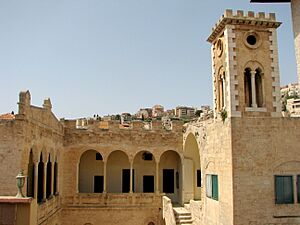
Zahir built the Seraya government house in Nazareth. It served as the city's main government building until 1991.
Haifa's Buildings
Between 1765 and 1769, Zahir had Haifa torn down and rebuilt. He fortified it at a new site about 3 km (1.9 mi) to the southeast. The old village was on a flat plain. The new town, which was still a port, was built on a narrow strip of land at the northern base of Mount Carmel. This made it easier to defend by land. In the new Haifa, Zahir built a wall around the town with four towers and two gates. None of these still exist. They were there until at least the early 1800s. Inside Haifa, Zahir built Burj al-Salam, a two-story square tower. It remained intact until the 1970s. The original great mosque in new Haifa was probably built by Zahir. But most of the current building is newer. He also built a customs building and a government residence. The remains of the government residence are a few arched rooms in a car park. The eastern part is used for storage.
Tiberias's Buildings
Zahir built forts around Tiberias in 1739–1740. Part of the walls originally ran along the shore of the Sea of Galilee and had eighteen towers. The forts were badly damaged in the 1837 earthquake. Most of the walls have been destroyed or are part of modern buildings. Eight of the towers still stand.
The two-story square fort with its four round towers is still standing. It is in the northeastern part of the forts. Both stories of the fort have three rows of arched ceilings. The fort was built by Zahir's son Salibi. As of 2001, the upper floor was a restaurant, and the lower floor had an art gallery. The fort is often wrongly called the "Crusader castle/fortress" by locals.
In the current center of Tiberias, Zahir built a mosque. It is known as the Omari Mosque or the Zahiri Mosque. It has a prayer hall, a porch, and a minaret (tower). It was built with alternating white and black stone. This was a common style in Zahir's buildings. While there have been restorations since it was first built in the 1740s, the mosque still has its original design.
Village Buildings
Forts and other buildings were constructed in the rural villages Zahir controlled. The Zaydans built a double wall around Deir Hanna. This made it "the best example of a fortified village in the Galilee." Zahir's brother Sa'd built the inner walls and the twelve towers above them. Zahir built the outer walls. His son Ali added towers, separate from the walls, on the eastern and western sides. They also built a palace complex, including a mosque. The Zaydans' buildings in Deir Hanna were badly damaged during Jazzar Pasha's attack. Still, large parts of the structures remain. As late as 1960, the town still looked like a fortress. No buildings were built outside the original fort lines.
North of Deir Kifa (in Lebanon), Zahir built the castle of Kulat Marun. In Khirbat Jiddin, Zahir rebuilt the destroyed Crusader fortress. He added a mosque and a bathhouse. The mosque was destroyed by Israeli forces in 1948. In Shefa-Amr, Zahir's son Uthman built a large fort with four towers. One of them still stands. His son Ahmad rebuilt the Crusader fortress in Saffuriya. In the village of I'billin, Zahir's brother Yusuf built forts and a mosque. The I'billin fortress was later used as the headquarters of Aqil Agha, a powerful Arab leader in the Galilee in the 1800s.
In Tibnin, in modern Lebanon, and in Safed, Zahir or his son Ali rebuilt Crusader forts. Zahir fortified the village of Harbaj. But the village and its fort were in ruins by the late 1800s. At Tabgha on the Sea of Galilee, Zahir built five fountains. One of them was still standing by the 1800s. That remaining fountain was the largest of its kind in the Galilee.
Images for kids


